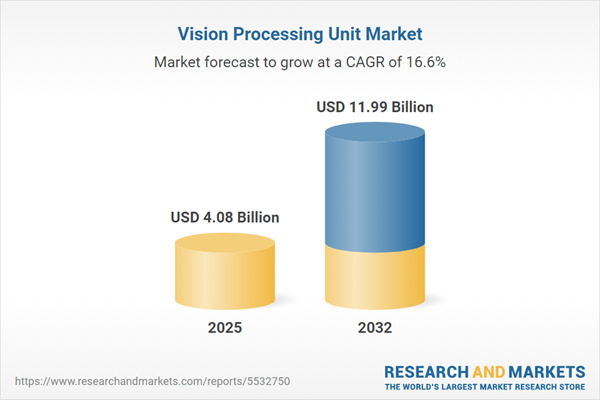Speak directly to the analyst to clarify any post sales queries you may have.
Vision Processing Units (VPUs) are transforming enterprise digital infrastructure by enhancing automation, operational flexibility, and intelligent decision-making across key industries. With accelerated integration into business systems, VPUs are considered fundamental for maintaining competitive advantage in a fast-evolving digital landscape.
Market Snapshot: Vision Processing Unit Market Size and Dynamics
The Vision Processing Unit market is valued at USD 3.51 billion in 2024. It is projected to reach USD 4.08 billion by 2025 and USD 11.99 billion by 2032, demonstrating a CAGR of 16.57%. Industry growth is fueled by continual investment in artificial intelligence, increasing implementation of edge computing, and demand for advanced imaging capabilities. Enterprises are adopting VPUs to power intelligent imaging systems and ensure business continuity, while ongoing adjustments in regulatory requirements and supply chain shifts are intensifying needs for compliance and adaptability in the global market.
Scope & Segmentation: Strategic Opportunities in the Vision Processing Unit Market
This analysis delivers vital segmentation to guide technology executives, enabling targeted investments and refined operational strategies. The following categories outline major drivers influencing VPU adoption in global and regional contexts:
- Application Areas: Automotive safety, advanced driver assistance, connected infotainment, robotics, medical imaging, consumer electronics, industrial automation, surveillance, and home connectivity benefit from automated visual data processing capabilities.
- Architectural Approaches: Custom and standard integrated circuits, neural accelerators, graphics chipsets, field-programmable gate arrays, and digital signal processors each provide computational solutions tailored to deployment environments.
- End Users: Distributors, original design manufacturers, equipment suppliers, and system integrators adapt VPU products to match sector-specific and client-driven requirements.
- Performance Classes: VPUs are engineered for high-intensity computations in demanding settings, yet remain flexible and scalable for diverse enterprise applications.
- Memory Interfaces: High-bandwidth memory, SDRAM, LPDDR4, and LPDDR5 interfaces deliver low-latency, high-throughput performance for real-time imaging tasks.
- Distribution Channels: Organizations utilize direct procurement, alliances, and digital platforms to ensure efficient sourcing aligned with technology mandates.
- Regional Markets: The Americas drive automation at the edge, Europe advances productivity through automation, and Asia-Pacific spearheads embedded vision and IoT projects. Each market features distinct innovation cycles and regulatory influences.
- Key Competitors: Prominent entities such as Intel Corporation, NVIDIA Corporation, Qualcomm Incorporated, Ambarella, CEVA, Mobileye Global Inc., Cadence Design Systems, Samsung Electronics, NXP Semiconductors, and Texas Instruments lead innovation and market dynamics through R&D and ecosystem partnerships.
Key Takeaways for Senior Decision-Makers
- VPUs enable real-time analytics at the network edge, supporting informed and agile decision-making within dynamic environments.
- Modular VPU designs streamline system integration, allowing organizations to rapidly scale digital solutions in line with evolving technology requirements.
- Strategic collaborations within the semiconductor industry, including work with systems integrators and cloud providers, facilitate scalable and responsive deployments.
- Integrating VPUs enhances operational reliability and system uptime for critical sectors such as automotive, healthcare, surveillance, and enterprise data centers.
- Adapting to regional requirements allows enterprises to respond effectively to compliance demands, procurement challenges, and market-specific opportunities, strengthening international competitiveness.
- Robust vendor management and transparent sourcing workflows increase supply chain security, enable better cost control, and reduce compliance risk.
Tariff Impact: United States 2025 Tariffs on Vision Processing Units
The impending introduction of United States tariffs on Vision Processing Units in 2025 is leading organizations to diversify supply chains and consider domestic or nearshore sourcing. Senior leadership teams are strengthening global partnerships and emphasizing operational flexibility to preserve competitiveness as regulations evolve.
Methodology & Data Sources
This study synthesizes comprehensive secondary research and insights from senior professionals in semiconductor manufacturing and system integration. A data triangulation approach ensures accuracy, producing actionable insights for strategic planning in the Vision Processing Unit sector.
Why This Vision Processing Unit Market Report Matters
- Provides executive teams with strategic guidance for effective procurement and technology roadmaps based on proven market shifts.
- Equips decision-makers to address compliance needs, minimize vendor risk, and select optimal partners in complex supply ecosystems.
- Enables resilient supply chain strategies that respond to regulatory changes and technological advancements.
Conclusion
Applying targeted segmentation and current market intelligence enables organizations to drive innovation, accelerate technology adoption, and sustain operational resilience in the evolving visual computing environment.
Additional Product Information:
- Purchase of this report includes 1 year online access with quarterly updates.
- This report can be updated on request. Please contact our Customer Experience team using the Ask a Question widget on our website.
Table of Contents
3. Executive Summary
4. Market Overview
7. Cumulative Impact of Artificial Intelligence 2025
Companies Mentioned
The companies profiled in this Vision Processing Unit market report include:- Intel Corporation
- NVIDIA Corporation
- Qualcomm Incorporated
- Ambarella, Inc.
- CEVA, Inc.
- Mobileye Global Inc.
- Cadence Design Systems, Inc.
- Samsung Electronics Co., Ltd.
- NXP Semiconductors N.V.
- Texas Instruments Incorporated
Table Information
| Report Attribute | Details |
|---|---|
| No. of Pages | 194 |
| Published | October 2025 |
| Forecast Period | 2025 - 2032 |
| Estimated Market Value ( USD | $ 4.08 Billion |
| Forecasted Market Value ( USD | $ 11.99 Billion |
| Compound Annual Growth Rate | 16.5% |
| Regions Covered | Global |
| No. of Companies Mentioned | 11 |









